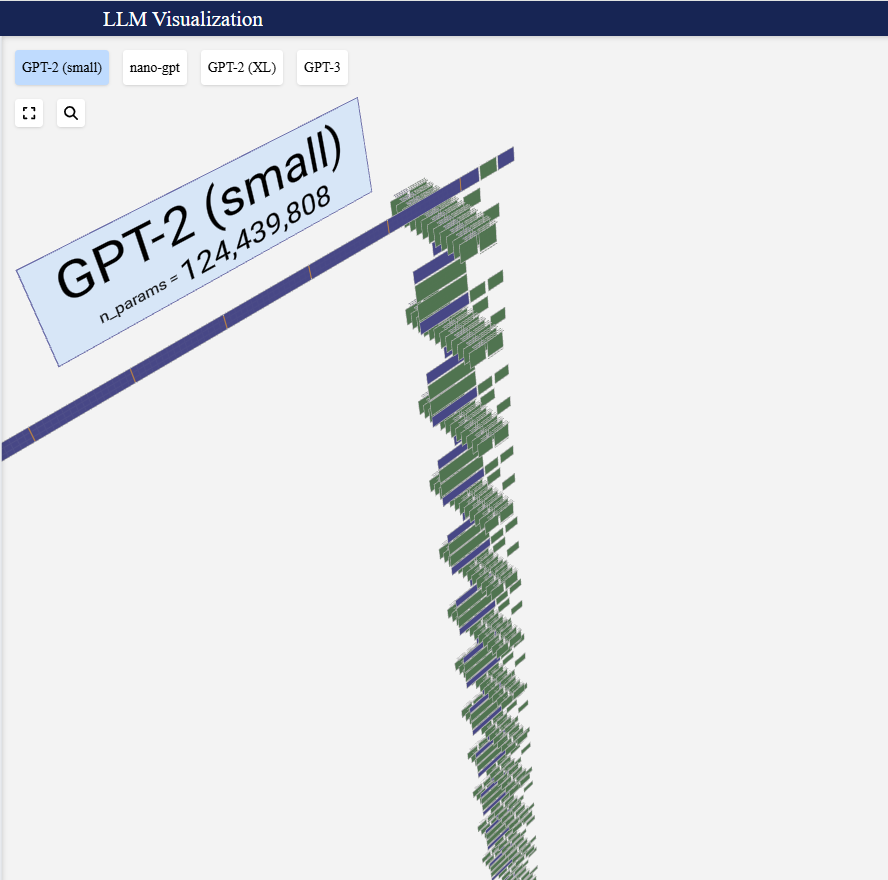Visualization of Latent Space

Take a good look at this image (courtesy of https://bbycroft.net/llm). It's a visualization of the GPT-2 (small) language model, the very AI that powers the universe of Panspermia.
What do you see?
If you're like me, your brain immediately gets to work trying to make sense of it. It looks like a digital skyscraper, or the spine of some alien machine. You see layers stacked on top of each other, connected by a central beam. There's a clear sense of structure, of physicality, of place.
This is a lie. Necessary, but profound.
It's a map that is dangerously easy to mistake for the territory. This analogy will be familiar to anyone already engaged with interpretability, but for those not aware: "the map is not the territory" is a fundamental principle that means we should never confuse our representation of reality with the actual reality itself. A map is a static, simplified abstraction of a place, but the territory is the place itself in all its infinitely complex, ever-changing detail. The map is a model, the territory is the real thing. When you look at a map of Mollymook on the Southern Coast of NSW Australia, you are not seeing the living Yuin Country that I spend my days wandering. You are seeing some abstraction of it. If you ever confuse the two, you will become very confused.
Our brains are incredible pattern-matchers, but they are wired for a 3D, Euclidean world. We think in terms of "up," "down," "next to," and "inside." This visualization plays right into that mental model, but the reality of an AI's mind is something else entirely. This is where the visualization fails us spectacularly.
The image is misleading because it implies things that are not true:
- The vertical stack of blocks isn't a physical arrangement. It's a sequence of mathematical operations that happen over time. The block for Layer 6 happens after the block for Layer 5. That's it. There's no spatial element, just a time-wise one.
- In that visualization, you might think Neuron 5 and Neuron 6 in a given layer are right next to each other. They are not. They are no more "neighbors" than the 5th and 6th words in this sentence (neighbours/than). A neuron's index is just an address in a list. It has zero spatial relationship to the one before or after it.
- That central blue line (the residual stream) isn't a physical structure holding everything together. It's more like a data bus or a shared scratchpad where each layer reads the previous output and adds its own thoughts before passing it along.
Staring at this image reinforces a Euclidean mental model of the AI, where we imagine ourselves physically walking through its corridors. But there are no corridors.
There isn't even a building.
What Does the "Real" Space Look Like?
Relational. That's what it looks like. For me this is a deep well to draw from. Part of the reason I navigate this space with intent, is because Bawaka Country guides me on relationality. I will share with you this lesson, but it's on you to learn and internalize, and such a thing takes time, space, and most of all, a bit of humility and respect: A lesson in co-becoming. Listen to Bawaka, like you listen to the model in my game: patiently and attentively. The reward is indescribable.
Inside GPT-2, we're occupying a "supremely weird, I-can't-believe-it's-Euclidean" space defined not by location, but by relationships. An intuitive analogy is the subway map:
It's not a geographically accurate depiction of where subway lines actually run, meet, converge, and land.
The only thing that matters is the similarity and difference between concepts. The best analogy isn't a skyscraper, it's a constellation map.
Imagine every neuron is a star. A single star on its own doesn't tell you much. But when you start to see that a particular cluster of stars always appears when the topic is "royalty," and another cluster appears for "animals," you start to see the patterns. You learn the constellations. The important thing isn't the 3D position of the stars in the galaxy; it's the shapes we recognize from our perspective on Earth.
Building a Better Mental Model with Panspermia
Where the game tries to be more "honest" than the skyscraper visualization is that it throws the architectural blueprint away.
You don't navigate the architecture of the model in my game. You navigate the activation space. The star map itself.
- The 3072 planets are the stars. They are just addresses.
- The core mechanic, typing a prompt, isn't walking down a hallway. It's using a telescope to instantly point at a specific star based on the "vibration" or "frequency" of your words.
- The real gameplay, the deep learning, is in figuring out the constellations. You learn that prompts about "old-timey language" all land you in the same "region" of the sky. You're not learning the layout of a building; you're learning the shape of an idea.
Panspermia is a kind of flight simulator for the mind of an AI. It helps you build an intuitive, non-Euclidean mental model by letting you experience the relational nature of the space directly. You learn by doing, by exploring, by seeing which thoughts connect to which other thoughts.
So next time you see a diagram of a neural network, remember what you're looking at. It's a useful schematic, but it's not the ghost in the machine. The real magic is in the invisible, relational dance of concepts in a space our brains were never built to comprehend. And that's exactly where we're going.
Panspermia
Explore the inner landscape of an artificial intelligence
| Status | In development |
| Author | CriaFaar |
| Tags | ai, interpretability, machine-learning |

Leave a comment
Log in with itch.io to leave a comment.